
Newsletter of the Shell Club of Sydney
NSW Branch, The Malacological Society of Australasia Limited ACN 067 894 848
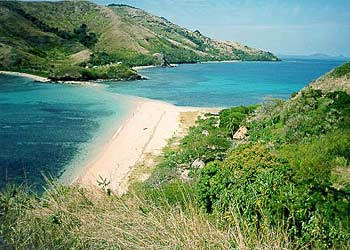
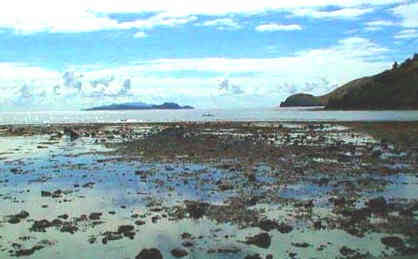
Waya Is Fiji
Note many of the pictures in this issue are from elsewhere on the
internet.
Meeting Minutes
28/06/03
The meeting was opened by P Jansen at 2.41 pm following the AGM.
Field Trips
M. Keats reported finding a couple of unusual species from Long Bay/Malabar. Michael is planning to produce a complete site survey from this location in the near future.
P. Jansen reported on her recent overseas trip and explained how the article in the "Sheller" on the Caspian
Sea came about.
General Business
M. Keats discussed a presentation on Chinaman's Beach. Mosman Council have a bid in to get a research grant to investigate the site. Michael also tabled a newspaper article for the "Sheller".
S. Dean handed around a copy of Neville Coleman's new book "2002 Sea Shells"
E-mail to and from Des Beechey re- possible financial assistance MSA for branch printer, tabled by C. Barnes.
Presentation
A shell auction took the place of a presentation.
Meeting Minutes
26/07/03
The meeting was opened by P Jansen at 2.02 pm.
Field Trips
C. Barnes reported finding a Cypraea poraria Linnaeus, 1758 ,
Strombus labiatus (Röding,1798) form Long Bay and a Trigonostoma bicolour (Hinds, 1843) from Little Bay.
Ashley Miskelly collected some sand dollars from Shoal Bay. Ashley commented that he was now finding more tropical urchins than during his previous fifteen years of diving.
P. Jansen reported on her recent trip to the Capricorn Coast of Queensland. Patty will discuss her finds in her presentation at the next meeting.
General Business
John Riley was introduced to the meeting as a potential member. John has an interest in native orchids, botanical art and has been a shell collector for many years. As a shearer he has had access to some remote places throughout Australia.
Peter Pienaar reminded the meeting that subscriptions to the Sydney Sheller were now due. A Motion was put by John Franklin to increase the membership fee to $40.00; Junior $15.00 and an extra $5 charge per
overseas Membership to cover postage. Peter Pienaar seconded the motion and it was passed unanimously by the meeting.
John Franklin has consented to continue as Club librarian.
C. Barnes tabled a copy of Tide Watch from Townsville Shell Club.
The meeting welcomed visitors: Susan and William Zilber.
Presentation
A. Miskelly gave a presentation on Sand dollars (Echinoderms). He discussed the specialised morphology of the food grooves and distribution of various species from Mexico, the USA and Africa.
Minutes of the AGM of the NSW Branch of the Malacological Society of Australasia Limited ACN 067 894 848 held in a Meeting Room at Ryde Eastwood Leagues Club
28/06/2003.
The meeting was opened by P Jansen at 2.10 pm, following a minute silence to mark the passing of Kevin Lamprell.
All office bearers with the exception of treasurer (John Franklin, who is believed to be standing down) were unanimously re-elected. Peter Pienaar agreed to fill the treasurers position once Johns' situation was clarified.
The presidents' report has been published in the "Sheller", and Patty thanked everyone for their input.
R. Moylan read the Treasurers Report and passed on all the necessary information in J. Franklin's absence. P. Jansen
moved to accept, seconded by M. Keats.
Draft Programme for year to come .
|
Month
|
Presentation
|
Cake
Roster
|
|
July
|
Ashley
Miskelly : Sand Dollars
|
Patty
Jansen
|
|
August
|
Patty
Jansen: Queensland trip
|
Steve
& Keith Dean
|
|
September
|
TBA
|
Peter
Pienaar
|
|
October
|
Annual
Shell Show
|
Everybody
to contribute
|
|
November
|
Ron
Moylan: Swains Reef
|
Sandra
Montague
|
|
December
|
Christmas
Party
|
Christmas
Party
|
|
January
|
Members’
Talks
|
John
Dunkerley
|
|
February
|
Patty
Jansen: Drawing lessons
|
Ron
Moylan
|
|
March
|
Ashley
Miskelly: TBA
|
Chris
Barnes
|
|
April
|
Michael
Keats: 12 month survey of Long Bay
|
Michael
Keats
|
|
May
|
TBA
|
TBA
|
|
June
|
Des
Beechey: TBA
|
Maureen
Anderson
|
Meeting Minutes
23/08/03
The meeting was opened by P Jansen at 2.15 pm.
Field Trips
Ashley Miskelly reported on a field trip to Bottle & Glass Rocks at Vaucluse in Sydney Harbour. Ashley reported finding a
specimen of Maoricolpus roseus (Quoy & Gaimard, 1834) at approximately 10 to 18 metres. Ashley has collected similar specimens over the past five or six years. The N.Z shell is becoming more common in Sydney.
Ashley also displayed fine specimens of Cypraea carneola Linnaeus, 1758 and
C. vitellus Linnaeus, 1758 from the same locality, plus an unusual hard coral.
J. Dunkerley reported on a visit to Green Island off Cairns in Qld. John mentioned that the Cay was part of the Marine
Reserve though he was able to make observations of a number of species including,
Lambis lambis Linnaeus, 1758 and Strombus luhuanus Linnaeus, 1758, which was plentiful. John added that he saw a baler shell while snorkelling and that the north side of the Island had lots of sea grass meadows with many species of shells and fish.
General Business
Categories for the October annual shell show were agreed after some discussion from the meeting.
*Note :- there is no physical size limit for specimens only number of specimens in each category,
and the quantity indicated is the maximum, less is acceptable.
1) Cypraeidae 15 specimens
2) Murex 15 specimens
3) Volutidae 15 specimens
4) Conidae 15 specimens
5) One locality 15 specimens (6km radius)
6) Local Sydney Shells 15 specimens
7) Shell of the Show, 1 specimen
8) Shell of the Show "Wow factor" 1 specimen
9) Bivalves 15 specimens
10) Ranellidae 15 specimens
11) Your Favourite Shells 10 specimens
Letter Gavin Malcolm U.K (tabled).
Presentation
P. Jansen gave a presentation on the family trip to Rockhampton and Townsville near Yeppoon on the Capricorn Coast in north Qld. Patty described the muddy sand flats, shallow water and tides that go out such a long way. Patty explained that the beach at Yeppoon is made up almost entirely of one member of the family Turritellidae,
Haustator cingulifera (Sowerby, 1825). Patty also reported on the thousands of soldier crabs that were encountered. Patty attended both Yeppoon and Townsville Shell Shows and was asked to judge at both events. Patty described both shows as having a high standard and added that Townsville is one of the larger clubs with many young members. Patty said the trip back was quite long, as it took two and a half days to drive back to Sydney.
Shell Club Library Corner:-
John Franklin
As a part of our Mission Statement the purpose of the library is not only to increase awareness and understanding but also to encourage research and to assist those pursuing their endeavours.
Please note that all books and materials have to date been donated to the Club. In the event that you have any books, articles and periodicals that have ceased to be of use, perhaps you could donate them to the Club to assist with research.
Your gift/donation would be greatly appreciated.
For a list of books/materials we have available in the library please refer to recent editions of the Sheller.
Acquisitions now include:
Coleman, N., 2001. 1001 Nudibranchs - catalogue of Indo-Pacific
slugs, Neville Coleman's Underwater Geographic Pty Ltd
Hinton, A., 1978. Guide to shells of Papua New Guinea, Robert Brown & Associates Pty Ltd, Port Moresby
Macpherson, J.H. and Gabriel, C.J., 1962. Marine molluscs of
Victoria, Melbourne University Press, National Museum of Victoria
Lamprell, K. and Healy, J., 1998. Bivalves of Australia Vol 2, Backbuys Publishers, Leiden
Cernohorsky, W.O., 1991. Monographs of marine mollusca, the mitridae of the world Part 2 the subfamilies Imbricariinae and Cylindromitrinae
Mamanuca Island Group - Fiji
John Franklin
At last the planned shelling trip became a reality as suddenly there was a pervasive feeling of the thrust of the plane's engine power catapulting us along the runway of Sydney's downtown Mascot International Airport towards Viti Levu, Nadi, Fiji, located some 3,100 kms and three hours flying time away.
To the original inhabitants, the island group was known as "Viti" and following both the Tongan influence and European colonisation the name for the islands became Fiji. In his journal Captain Cook used the word "Feejee" to describe the people of Fiji.
Only 100 of the approximate 330 islands in the archipelago are inhabited with a current total population of nearly 800,000.
Interestingly whilst the 180o meridian passes through Taveuni the international Date Line is regarded as being drawn eastward of that island so that all of the islands share the same time zone.
After booking into our hotel, we went shopping and visited the Nandi markets. Whilst the quality of the shells for sale at the markets was very poor, the department stores did not disappoint, offering an excellent range from inexpensive to shells like
Conus gloriamaris, Conus milneedwardsi, Conus dusaveli, Conus cedonulli, Cypraea aurantium and
Cypraea teulerei just to name a few.
The weather was warm to hot as we boarded the boat on the Saturday afternoon at Denarau Island wharf, to take us for a three day cruise of the Mamanuca Island Group.
It was not long before the boat glided past Vuda Point peninsula which projects into the sea and faces the Mamanucas. An extensive mountainous range provides a beautiful backdrop to the Point which incidentally was the first landing place of the Melanesians arriving in Fiji so many centuries ago.
The final point of call was the island of Tivua which is located only a short distance from mainland Lautoka on the western coast of Viti Levu. Tivua is not a volcanic island but rather small and circular.
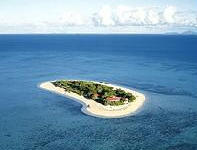
Whilst snorkelling provided wonderful views of both soft and hard corals, colourful fish and blue starfish, it was from the two hour walk around the island in the falling sunlight that some observations of molluscan life could be made as follows:
Cephalopoda, Nautilus pompilius, this species from Fiji is smaller than those collected from the Philippine Islands.
Codaki paytenorum, Iredale 1937
Mitrella Ligula, Dulcos 1840
Early next morning we weighed anchor and set sail for Narokorokoyawa the Sacred Island Group located north west of Tivua Island. Finally after about two hours we sailed into the beautiful clear crystal waters of Navadra Island, just one of five islands in the group. Indeed the Sacred Islands are special in many ways, firstly because they have a cultural significance in that it was the first place of landing of the Fijian chief Tui Na Revurevu and his crew in a canoe "Rogovoka". The chief set up a fortress, a village and Sacred Caves known as "Navanualevu". It was indeed unfortunate that the first Fijians were compelled to leave their island paradise mainly because of the lack of fresh water. They proceeded to the mainland and settled at a place known as Vuda "the source" on Vitu
Levu.
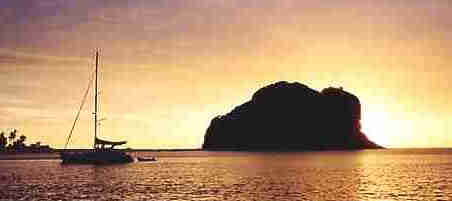
Apart from cultural aspects, for the visitor to Navadra Island one cannot but resist falling in love with the beauty of the place. There is a small horseshoe bay and as the boat proceeded up the centre on one side there was a tall volcanic rock, then a long white sandy beach behind which were swaying palm trees embedded in a luxuriant green undergrowth. In about the middle of this beach a small track leading into the bushes could be discerned. This track led to the Sacred Cave. Then turning slowly from right to left there are rocks covered with sand in the middle of the horseshoe. At high tide the water covers the sand, but the passage is still very shallow. On the left hand side of the bay is the beautiful Navadra Beach which had a rocky point at one end. Beyond the beach volcanic rocks fell into the entrance of the bay. Small clam shells were washed upon the beach along with other shells located at low tide amongst the rocks and coral rubble.
Conus balteatus, Sowerby 1833, Conus boeticus, Reeve 1843,
Cypraea caputserpentis, Linne 1758, Cypraea
annulus, Linne 1758, Cypraea moneta, Linne 1758, Mitra
decurtata, Reeve 1843, Mitra litterata lamarck, Terebra
Maculata, and Terebra dimidiata, Linne 1758, just to mention a few of the species present.
In the afternoon we sailed past the majestic Mount Batinareba (510m) to Nova Bay being part of the beautiful and rugged island of Waya located at the southern end of the Yasawa Island Group. The Nova Bay beach was rather small and at low tide many
Terebra subulata, Linne 1758 were present in the shallow water.
The next morning we visited Octopus Beach, at Nalauwaki Bay, Waya. The ladies of the village were selling shells and handicrafts. There were black lipped pearl shells, many
Cypraea tigris in mostly bad condition, Lambis lambis, Lambis scorpius, Lambis crocata
and Lambis truncata. In addition, there were many smaller Strombus for sale.
In the afternoon we sailed for Naboro village located on the island of Wayasewa. The village was relocated in 1975 following a rockslide from cliffs at the old historical site Namara. The new site of Noboro village is located on a spectacular site, the high grassy hills behind the village provide a theatrical backdrop for play acting, story-telling and dances. As we walked through the stalls of shells, arts and crafts for sale we were greeted by delightful school children who took us for an inspection of their school and performed for us.
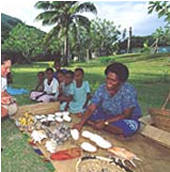
Wayasewa is approximately 40km north west of Lautoka and is divided from Waya at Bonini Point by only a short strip of shallow water. From the Point one can look across to the mainland and see the beautiful hazy pastel blue mountains falling into the sea.
We travelled across this shallow water to the Waya side and collected mainly small species of the Mitridae and Costellaridae families. This area is truly and beautiful place to visit.
And so, our short boat trip came to an end leaving time for a visit to the Lautoka and Sigatoka markets. On the whole, both markets did not offer expensive or indeed good quality shells. The elusive
Cypraea eburnea (Barnes 1924) was not available for purchase. By way of contrast however, the larger stores/shops did offer quality specimens usually at high prices, for example
Cypraea aurantium (Gmelin 1791) was almost in every shop for sale at a premium price.
In such a short period of our stay in Fiji we only obtained a glimpse of the existing molluscan life and it will be left to a lengthier future visit whereby it is hoped we shall be able to obtain a representative knowledge of the existence of particular species in the area.
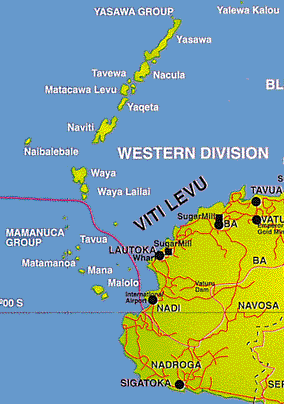 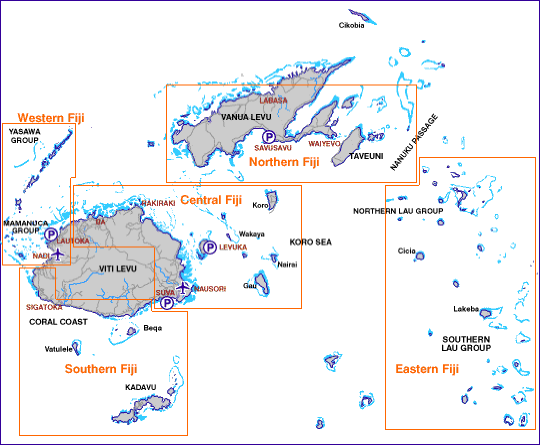
Mysterious Creatures
Steve Dean
Over three years ago, immediately prior to the National Shell Show In Adelaide, I spent three days and nights collecting on the York Peninsula. (Permit organised by the Adelaide Shell Club). On the second night I came across a creature that did not resemble any sea creature I had heard of before. It was on sand just out of the water at low tide and was heading back to the water covered weed beds on the expansive sand flats. (The adjoining weed beds were littered with many thousands of juvenile live Phasianella shells) It was raining heavy, extremely windy, cold and was 2AM, so visibility was poor.
Here is how I described the creature when I gave my field trip report back in Sydney:
- Large elongated, flattened hard rubber block 25cm long and roughly the shape of a garden slater.
- The underside had rows of sucker feet similar to an enlarged grub, but with pairs of feet along the full length of the
underside making the underside appear segmented.
- In spite of its tough thick skin the animal could curl up to protect its underside when I rolled it over with my shoe
- It was hairy along its sides and smooth along the top (The top skin almost like a tough Beach-De-Mer)
- (Members were starting to look at me strangely, but the last part of the description clinched it)
- Along the underside periphery amongst the hairs, there was what looked like rows of 2cm long brass wires sticking
out of the body. They were very shiny and hard. I did not want to push them too hard in case they, or the hairs were
poisonous.
No one knew what it was, and from the looks of our members, I could tell they thought I was going mad.
I now know what it was. It was a Polychaetes worm in the Genus Aphrodita The common name is "Sea Mouse"
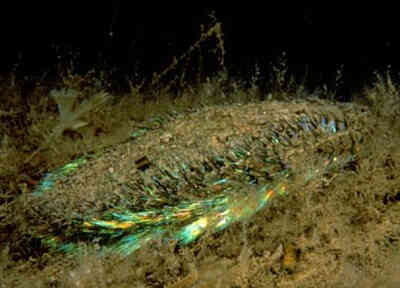
These worms normally live half buried in silt form 2m to 2000m so I do not know what mine was doing on pristine clean sand, trapped out of water at low tide, and 400m from where the sand flats drop into deeper water.
The "brass" looking spines are exciting Physics and communications experts worldwide as they transmit light with almost 100% efficiency far superior to current fibre optics. Like the wings of some butterflies they spines are iridescent and reflect when light shines on them. They look red and with blues and greens, hence their "brass look" under my torch light.
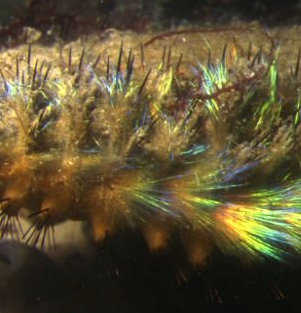
Close up of hairs, spines, feet and top of body.
Each spine has a central hollow surrounded by 100,000 hexagonal hollow tubes. (Each hollow tub running along the spine is 0.0000005m diameter - ˝ micron) The tubes are arranged in perfect symmetry and each tube is hexagonal. This is eight times denser than the most advanced optical fibres (Photonic Crystal Fibres). Research is underway to try to identify how the sea monkey makes its fibres to see if we can duplicate them. Other research is looking to make such fibres by direct molecular reconstruction. (Research was being done in Bath UK, Sydney Aust, and USA)
The other potential use for such strands is to colour things where the colour is generated by light refraction rather than light absorption. Human made articles coloured this way would never 'fade'.
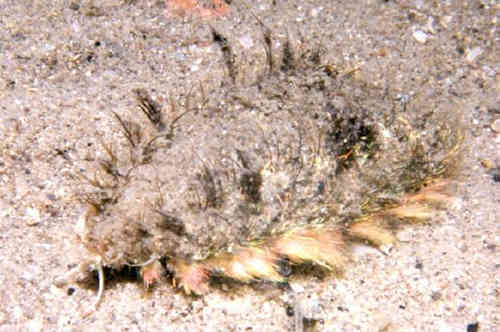
|










